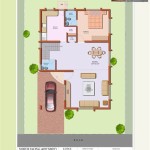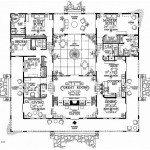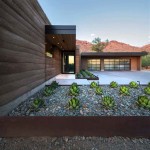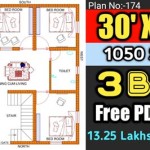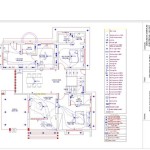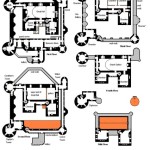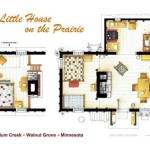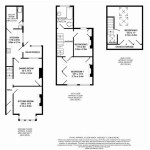Floor Plans for 1400 Sq Ft Home: Maximizing Space and Functionality
Designing a 1400 square foot home presents a compelling challenge: how to balance comfortable living with optimal space utilization. This size offers a sweet spot, providing enough room for families or individuals while remaining manageable in terms of construction costs and maintenance. Effective floor plans for 1400 sq ft homes require careful consideration of layout, traffic flow, storage solutions, and the specific needs and preferences of the occupants. This article will explore various aspects of designing desirable floor plans for this common home size.
The first step in developing a floor plan is to define the priorities for the space. Consider the desired number of bedrooms and bathrooms. Will it be a single-story or two-story design? Is a dedicated home office a necessity, or can a flexible space serve multiple purposes? What is the desired style of living – open-concept versus more defined, separate rooms? Answering these fundamental questions will guide the development of a floor plan that aligns with the homeowner's vision. It is also crucial to take into account site considerations, such as lot size, orientation, and any local building codes or restrictions that might impact the design.
The architectural style of the house also significantly influences the floor plan. A modern, minimalist design might prioritize open living spaces and clean lines, while a traditional farmhouse style might incorporate a larger kitchen and more enclosed rooms. Understanding the desired aesthetic helps to create a cohesive and functional layout that complements the overall architecture. The flow between indoor and outdoor spaces should also be carefully considered. Integrating patios, decks, or screened porches can extend the living space and enhance the enjoyment of the home.
Key Point 1: Analyzing Common Floor Plan Layouts
Several popular floor plan layouts are commonly employed for 1400 sq ft homes. These layouts are often categorized based on the placement of bedrooms and living areas, as well as the overall flow of the house. Understanding these basic layouts will provide a strong foundation for designing a customized plan that meets specific needs.
One of the most common layouts is the ranch-style floor plan, which features all living spaces on a single level. This layout is particularly attractive for individuals with mobility concerns or those who prefer the convenience of single-story living. A ranch-style floor plan typically includes an open living area encompassing the living room, dining area, and kitchen. Bedrooms are usually located on one side of the house, providing a degree of separation from the main living areas. This design lends itself well to accessibility modifications and age-in-place considerations.
Another popular choice is the two-story floor plan, which maximizes the use of vertical space. This layout is often preferred when lot size is limited, as it allows for more living area without increasing the footprint of the house. Two-story homes typically feature the main living areas on the ground floor, with bedrooms and bathrooms located on the upper floor. This configuration offers a greater degree of privacy for the sleeping quarters and allows for more separation between living and sleeping areas. However, two-story homes require stairs, which may not be suitable for all individuals.
A split-level floor plan offers a compromise between the ranch-style and two-story designs. This layout features multiple levels connected by short sets of stairs. This design can be advantageous for separating different functions of the house, such as living areas, sleeping areas, and recreational spaces. Split-level homes can also adapt well to sloping sites, making them a versatile option for a variety of locations.
Finally, consider the open-concept floor plan, which has become increasingly popular in recent years. This layout emphasizes a seamless flow between the living room, dining area, and kitchen, creating a large, unified living space. Open-concept plans are ideal for entertaining and foster a sense of connection between family members. However, they can also be less conducive to privacy and may require careful attention to noise control and zoning.
Key Point 2: Optimizing Space Utilization
Effective space utilization is paramount in a 1400 sq ft home. Every room and every corner must be carefully considered to maximize functionality and minimize wasted space. Strategies for optimizing space include incorporating multi-functional furniture, utilizing vertical storage, and employing smart design techniques to create the illusion of more space.
Multi-functional furniture is a valuable asset in a smaller home. Examples include sofa beds, storage ottomans, and dining tables with built-in storage. These pieces can serve multiple purposes, reducing the need for separate pieces of furniture and freeing up valuable floor space. Wall-mounted desks and folding tables can also provide flexible workspace options that can be easily stowed away when not in use. In bedrooms, consider beds with built-in drawers or headboards with shelves to maximize storage capacity.
Vertical storage is another effective way to maximize space utilization. Shelves, cabinets, and drawers that extend to the ceiling can provide ample storage without taking up valuable floor space. In kitchens, consider utilizing tall cabinets, pantry organizers, and hanging pot racks to optimize storage capacity. In bathrooms, wall-mounted shelves and medicine cabinets can help to keep countertops clear and organized. Even in hallways and entryways, tall shelving units can provide storage for coats, shoes, and other items.
Smart design techniques can also contribute to the illusion of more space. Light colors and large windows can make a room feel brighter and more open. Mirrors strategically placed can reflect light and create the illusion of greater depth. Open shelving can create a sense of airiness, while minimal furniture and clutter can help to keep the space uncluttered and inviting. Using a consistent flooring material throughout the house can also create a sense of continuity and flow, making the space feel larger.
Furthermore, consider the placement of doors and hallways. Pocket doors, which slide into the wall, can save space compared to traditional swinging doors. Hallways should be kept as narrow as possible to minimize wasted space. Consider incorporating built-in niches or shelving into hallway walls to add storage and visual interest. The design should prioritize efficiency and eliminate unnecessary barriers or obstacles.
Key Point 3: Design Features and Considerations
Beyond the basic layout and space utilization, several key design features can significantly impact the functionality and livability of a 1400 sq ft home. These include kitchen design considerations, bathroom layouts, and the integration of universal design principles.
Kitchen design is crucial in any home, but it is particularly important in a smaller space. A well-designed kitchen should be both functional and aesthetically pleasing. The layout should optimize workflow, with the sink, refrigerator, and stove arranged in a logical sequence. Consider incorporating a kitchen island or peninsula to provide additional counter space and storage. Choosing appliances that are appropriately sized for the space is also important. Compact refrigerators, dishwashers, and ranges can save space without sacrificing functionality. Adequate lighting is essential, including both ambient lighting for general illumination and task lighting for specific work areas. Storage solutions such as pull-out shelves, drawer dividers, and corner organizers can help to maximize storage capacity and keep the kitchen organized.
Bathroom layouts should also be carefully considered. In a 1400 sq ft home, it is often necessary to prioritize functionality over luxury in the bathrooms. Consider using a shower instead of a bathtub to save space. Wall-mounted sinks and toilets can also free up floor space and create a more open feel. Adequate storage is essential for toiletries, towels, and other bathroom essentials. Utilizing vertical storage, such as shelves and medicine cabinets, can help to keep countertops clear and organized. Good ventilation is also important to prevent moisture buildup and maintain a healthy indoor environment.
Integrating universal design principles can enhance the accessibility and usability of the home for individuals of all ages and abilities. Universal design features include wider doorways, lever-handled door hardware, grab bars in bathrooms, and roll-in showers. These features can make the home more comfortable and convenient for individuals with mobility concerns, as well as for aging in place. Incorporating universal design principles can also increase the resale value of the home.
Finally, consider the energy efficiency of the home. Incorporating energy-efficient windows, insulation, and appliances can reduce energy consumption and lower utility bills. Utilizing passive solar design principles, such as orienting the house to maximize sunlight exposure in the winter and minimize it in the summer, can also improve energy efficiency. Installing a programmable thermostat can help to regulate the temperature and reduce energy waste.
Careful planning, thoughtful design, and attention to detail are essential for creating a floor plan that maximizes the potential of a 1400 sq ft home. By considering the factors outlined in this article, homeowners can create a comfortable, functional, and aesthetically pleasing living space that meets their specific needs and preferences.

1400 Sq Ft Open Floor Plans Google Search Ranch House New Small

Pin On With Two Cats In The Yard

House Plan 59003 Traditional Style With 1400 Sq Ft 3 Bed 2 Ba

Modern Style House Plan 2 Beds Baths 1400 Sq Ft 23 162 Houseplans Com

Traditional Style With 3 Bed 2 Bath Home Design Floor Plans Country House

3 Bed 2 5 Bath Ranch House Plan With 1400 Square Feet Coolhouseplans Blog

Adobe Southwestern Style House Plan 4 Beds 2 Baths 1400 Sq Ft 1 318 Unique Plans Bedroom Floor

1000 Sq Ft 1400 Suncrest Homes Full Service Manufactured Home S

Country House Plan With 1400 Square Feet And 3 Bedrooms S From Dream Home Source Code Dhsw2 Ranch Style Plans Homes

Pine Bluff House Plan 1400 Square Feet

